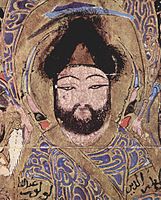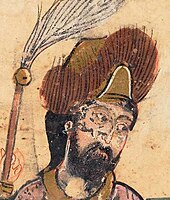Sharbūsh

The Sharbush or Harbush (Arabic: شَربوش sharbūsh, Greek: σαρπούζιν, Turkish: Serpuş) probably derived from Persian word Serpush[1] was a special Turkic military furred hat, worn in Central Asia and the Middle East in the Middle Ages. It appears prominently in the miniatures depicting Badr al-Din Lu'lu' (ruled 1234–1259).[2] It was a stiff cap of the military class, with a triangular front which was sometimes addorned with a metal plaque. It was sometimes supplemented with a small kerchief which formed a small turban, named takhfifa.[3] The wearing of the Sharbūsh was one of the key graphical and sartorial elements to differentiate Turkic figures from Arab ones in medieval Middle-Eastern miniatures.[4]
The Sharbush could vary in size and shape, sometimes taking huge proportions, as in the depiction of the emir in the frontispiece of the 1237 Maqamat of al-Hariri.[4] The shape of the sharbush seems to have varied depending on geographical regions:
- The sharbush of Artuqid manuscripts (example) has a very tall cap behind the headplate and the usage of fur around the rim is limited;[5]
- The Seljuk sharbush as seen on Persian ceramics, or on objects from Mosul such as the Blacas ewer, or in Jazira and Syria manuscripts had a much lower cap, almost hidden behind the band of fur surrounding the head and the frontal plate;[5]
- The frontispiece of the Baghdad Schefer Maqamat shows another sharbush, consisting of a tall mass of fur, hiding the cap from view.[5]
The sharbush headgear was a rallying sign for Saladin, and he wore it on his Mayyafariqin coinage.[6][7] When Henry II, Count of Champagne, king of Jerusalem, tried to build a friendly relationship with Saladin, he requested the gift of a qabā robe and a sharbūsh hat, which he wore in Acre.[8][9][10]
The Sharbush was also a symbol of investitute under the Egyptian Mamluks, as it was part of the khil'a given to an amir on the occasion of his accession.[7] The sharbush was worn by high-ranking officers of the Ayyubid and Bahri Mamluk period.[11][12]
In Mamluk Egypt, the wearing of the Sharbush was banned in 1382.[13][14]
- Right frontispiece: ruler in Turkic dress (long braids, large Sharbush fur hat, boots, fitting coat), in the Maqamat of al-Hariri, 1237 CE, probably Baghdad.[4]
- Turkic amir with guards, wearing the Turkic headgear Sharbush, in the preaching scene at Rayy in maqāma 21 (fols. 58v–59r), Maqamat of al-Hariri, 1237.[15][4]
- Warrior in Turkic attire, wearing the Turkic headgear sharbush, De Materia Medica of Dioscorides, Iraq, 1224. Harvard Art Museums.[16]
- Artuqid sharbush, 1206 (Ms. Ahmet III 3472)
- Sharbush of Badr al-Din Lu'lu' (Kitab al-Aghani, 1219 CE)
- Maqamat al-Hariri (BNF Arabe 3929, circa 1200-1210), Turkic ruler detail wearing the sharbūsh with the tall cap
- Maqamat al-Hariri (BNF Arabe 6094), Jazira region, 1222
- Donor figure wearing sharbush, qaba and tiraz. Church of the Archangels, Zemo-Krikhi, Racha, northern Georgia. 11th century, Inv. No. 03086-75.[20]
See also[edit]
References[edit]
- ^ E.J. Brill's First Encyclopaedia of Islam, 1913-1936. BRILL. p. 891. ISBN 9789004097940
- ^ Rice, D. S. (1953). "The Aghānī Miniatures and Religious Painting in Islam". The Burlington Magazine. 95 (601): 128–135. ISSN 0007-6287.
- ^ Yedida Kalfon Stillman, Norman A. Stillman (2003). Arab Dress: A Short History : from the Dawn of Islam to Modern Times. Leiden, Netherlands: Brill. p. 67. ISBN 9789004113732.
The normal headgear of the military class was a stiff cap with a triangular front which in some instances appears to have been a metallic plaque. It was sometimes trimmed with fur and was called a sharbUsh (see PI. 23 which depicts a Saljuq atabeg wearing a sharbUsh and tiriiz qabii' and also PI. 19), and sometimes it had a small kerchief bound around it to form a sort of turban which was designated a takhfifa. The sharbush was absolutely de rigueur for an amir.
- ^ a b c d Contadini, Anna (2012). A world of beasts: a thirteenth-century illustrated Arabic book on animals (the Kitāb Na't al-Ḥayawān) in the Ibn Bakhtīshū' tradition. Leiden Boston: Brill. p. 127. ISBN 978-90-04-20100-2.
Reference has already been made to the combination of boots and sharbūsh as markers of official status (...) the combination is standard, even being reflected in thirteenth-century Coptic paintings, and serves to distinguish, in Grabar's formulation, the world of the Turkish ruler and that of the Arab. (...) The type worn by the official figures in the 1237 Maqāmāt, depicted, for example, on fol. 59r,67 consists of a gold cap surmounted by a little round top and with fur trimming creating a triangular area at the front which either shows the gold cap or is a separate plaque. A particular imposing example in this manuscript is the massive sharbūsh with much more fur than usual that is worn by the princely official on the right frontispiece on fol. 1v.
- ^ a b c Ward, Rachel (1 January 1985). "Evidence for a School of Painting at the Artuqid Court". Oxfod Studies in Islamic Art, vol. 1, pp. 69-83: 77.
- ^ a b Nicolle, David (20 December 2011). Saladin. Bloomsbury Publishing. p. 26. ISBN 978-1-84908-318-8.
This copper dirham, minted at Mayyafariqin in 587 AH (1190/01 AD) shows Saladin wearing the sharbush hat of a Saljuq-style Turkish ruler.
- ^ a b c Lesley Baker, Patricia (1988). A History of Islamic Court Dress in the Middle East (PDF). SOAS, London University. p. 119. doi:10.25501/SOAS.00033676.
By the end of the 12th century, the wearing of the sharbush demonstrated support for Salah al-Din. Under the later Bahri Mamluks of Egypt and Syria it formed part of the khil'a given to an amir on his investiture.
- ^ Gabrieli, Francesco. Arab Historians of the Crusades. University of California Press. p. 242.
When the King of England left for home, Henry sent a messenger to Saladin to conciliate him and win his goodwill. He asked him for the gift of a robe of honor, and said: "You know that to put on the qabā and the sharbūsh is not approved among us, but I would put them on if they came from you, because of the regard I have for you." Saladin sent him sumtuous robes of honour, among them a qaba and a sharbush, and he wore them in Acre.
- ^ Mayer, Leo Ary (1952). Mamluk Costume: A Survey. A. Kundig. pp. 27–28.
Moreover, the wearing of the sharbish and qaba was considered so characeristic for a Saracenic amire that even a Crusader was prepared to don it in order to show some sort of friendship (if not allegiance) to Saladin.
- ^ Kedar, Benjamin Z.; Phillips, Jonathan; Riley-Smith, Jonathan (5 August 2016). Crusades: Volume 4. Taylor & Francis. p. 87. ISBN 978-1-351-98575-8.
- ^ Lesley Baker, Patricia (1988). A History of Islamic Court Dress in the Middle East (PDF). SOAS, London University. p. 119. doi:10.25501/SOAS.00033676.
The texts mention that high-ranking military officers in the early Bahri period wore the sharbush, as in the Seljuk and Ayyubid periods.
- ^ Dozy, Reinhart Pieter Anne; Nederlandsch instituut van wetenschappen, letterkunde en schoone kunsten (1845). Dictionnaire détaillé des noms des vêtements chez les Arabes; ouvrage couronné et publié par la Troisìeme classe de l'Institut royal des Pays-Bas. Amsterdam J. Müller. pp. 220–224.
- ^ Yedida Kalfon Stillman, Norman A. Stillman (2003). Arab Dress: A Short History : from the Dawn of Islam to Modern Times. Leiden, Netherlands: Brill. p. 67. ISBN 9789004113732.
- ^ Nicholas, Nick; Baloglou, George (2003), An Entertaining Tale of Quadrupeds: Translation and Commentary, Columbia University Press, p. 63, ISBN 9780231127608
- ^ Hillenbrand 2010, p. 118, note 10.
- ^ Contadini, Anna (2012). A world of beasts: a thirteenth-century illustrated Arabic book on animals (the Kitāb Na't al-Ḥayawān) in the Ibn Bakhtīshū' tradition. Leiden Boston: Brill. p. 127. ISBN 978-90-04-20100-2.
Reference has already been made to the combination of boots and sharbūsh as markers of official status (...) the combination is standard, even being reflected in thirteenth-century Coptic paintings, and serves to distinguish, in Grabar's formulation, the world of the Turkish ruler and that of the Arab. (...) The type worn by the official figures in the 1237 Maqāmāt, depicted, for example, on fol. 59r,67 consists of a gold cap surmounted by a little round top and with fur trimming creating a triangular area at the front which either shows the gold cap or is a separate plaque. A particular imposing example in this manuscript is the massive sharbūsh with much more fur than usual that is worn by the princely official on the right frontispiece on fol. 1v. (...) These are of yet another type and are identical to those on the official on the left holding a spear in the painting of the "Purple Betony" in the 1224 Dioscorides (Fig. 65b)
- ^ Eastmond, Antony (2017). Tamta's World: The Life and Encounters of a Medieval Noblewoman from the Middle East to Mongolia. Cambridge University Press. doi:10.1017/9781316711774. ISBN 9781316711774.
- ^ Balog (1980). The Coinage of the Ayyubids. London: Royal Numismatic Society. p. Coin 182., also Whelan Type III, 258-60; Album 791.4
- ^ For a similar coin at the British Museum minted in AH 586/1190 CE: "Saladin coin British Museum". www.britishmuseum.org., and another one also minted in 1190:
 . Also [1], [2]
. Also [1], [2] - ^ Flood, Finbarr Barry (2017). A Turk in the Dukhang? Comparative Perspectives on Elite Dress in Medieval Ladakh and the Caucasus. Austrian Academy of Science. p. 253, Fig. 20.
Works cited[edit]
- Hillenbrand, Robert (1 January 2010). "The Schefer Ḥarīrī: A Study in Islamic Frontispiece Design". Arab Painting: 117–134. doi:10.1163/9789004236615_011.


 French
French Deutsch
Deutsch![Right frontispiece: ruler in Turkic dress (long braids, large Sharbush fur hat, boots, fitting coat), in the Maqamat of al-Hariri, 1237 CE, probably Baghdad.[4]](http://upload.wikimedia.org/wikipedia/commons/thumb/a/a6/Maqamat_al-Hariri_1237%2C_Turkic_Emir_portrait.jpg/160px-Maqamat_al-Hariri_1237%2C_Turkic_Emir_portrait.jpg)
![Turkic amir with guards, wearing the Turkic headgear Sharbush, in the preaching scene at Rayy in maqāma 21 (fols. 58v–59r), Maqamat of al-Hariri, 1237.[15][4]](http://upload.wikimedia.org/wikipedia/commons/thumb/2/2b/Turkic_guard_in_Preaching_scene_at_Rayy_in_maq%C4%81ma_21_%28fols._58v%E2%80%9359r%2C_douvle-page_spread_as_a_unit%29%2C_Maqamat_al-Harari_1237.jpg/200px-Turkic_guard_in_Preaching_scene_at_Rayy_in_maq%C4%81ma_21_%28fols._58v%E2%80%9359r%2C_douvle-page_spread_as_a_unit%29%2C_Maqamat_al-Harari_1237.jpg)
![Warrior in Turkic attire, wearing the Turkic headgear sharbush, De Materia Medica of Dioscorides, Iraq, 1224. Harvard Art Museums.[16]](http://upload.wikimedia.org/wikipedia/commons/thumb/b/b2/Warrior_with_the_Plant_Kestron%2C_De_Materia_Medica_of_Dioscorides%2C_Iraq_1224._Harvard_Art_Museums.jpg/108px-Warrior_with_the_Plant_Kestron%2C_De_Materia_Medica_of_Dioscorides%2C_Iraq_1224._Harvard_Art_Museums.jpg)




![Sharbush in an Armenian manuscript, Haghbat Gospels, 1211.[17]](http://upload.wikimedia.org/wikipedia/commons/thumb/1/1e/Armenian_manuscript_%281211%29.jpg/145px-Armenian_manuscript_%281211%29.jpg)
![Dirham in the name of Saladin, wearing the Sharbush.[7][6] Legend: "The Victorious King, Righteousness of the World and the Faith, Yusuf ibn Ayyub". Probable Mayyafariqin mint, dated 1190-1191.[18][19]](http://upload.wikimedia.org/wikipedia/commons/thumb/7/7c/Al-Nasir_I_Salah_al-Din_Yusuf_%28Saladin%29._AH_564-589_%281169-1193_CE%29_%C3%86_Dirham_%2830.1mm%2C_13.28_g%2C_6h%29._Without_mint-name._Dated_AH_586_%28AD_1190-91%29._Sultan_sitting_facing%2C_cross-legged%2C_on_high-backed_throne_%28obverse%29.jpg/200px-thumbnail.jpg)
![Donor figure wearing sharbush, qaba and tiraz. Church of the Archangels, Zemo-Krikhi, Racha, northern Georgia. 11th century, Inv. No. 03086-75.[20]](http://upload.wikimedia.org/wikipedia/commons/thumb/c/cf/Donor_figure_wearing_sharbush%2C_qaba_and_tiraz._Church_of_the_Archangels%2C_Zemo-Krikhi%2C_Racha%2C_northern_Georgia%2C_Inv._No._03086-75.jpg/140px-Donor_figure_wearing_sharbush%2C_qaba_and_tiraz._Church_of_the_Archangels%2C_Zemo-Krikhi%2C_Racha%2C_northern_Georgia%2C_Inv._No._03086-75.jpg)
